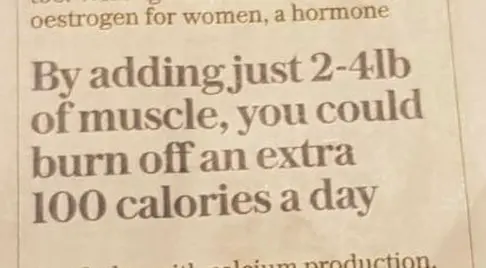
“Pack on the muscle and torch that fat!!”
“Turn yourself into a fat-burning inferno!!”
So scream the headlines and advertisements from just about every muscle and fitness mag you lay eyes on.
The story goes that you can increase your metabolism by 50 to 100 calories per day for every pound of muscle gained. It’s a line that’s been repeated so often by so many that it is taken as gospel, without questioning.
If your gym buddies (or, worse, your personal trainer) repeat the line that muscle gain significantly increases your metabolism, tell them to read this (or better yet, the scientific evidence) and stop perpetuating a myth.
Firstly, metabolism is often referred to as ‘metabolic rate’ or ‘resting metabolic rate’ (RMR). (You can get a good estimate of your RMR with our body composition calculator (and an even better one if you’ve had a Bodyscan DEXA scan because we can use a better formula).
RMR is just one component of energy expenditure and is, put simply, the number of calories (amount of energy) required to maintain the body’s most basic functions whilst at rest, and accounts for approximately 70% of total energy expenditure in sedentary individuals.
Although increasing muscle mass does have a minor effect on RMR, the magnitude of this is hugely overplayed. According to the scientific evidence, the number of calories burned by 1 pound of muscle at rest is approximately 6 calories per day, a far cry from the often touted 50 calories. (In metric that’s 13 calories per kilogram of muscle tissue per day.)
(By comparison, this study found that one pound of fat tissue burns approximately two calories per day at rest, whereas a pound of heart (yes, your heart) burns around 200 calories per day at rest. Indeed, the study labels the heart, kidneys, liver and brain as ‘high metabolic rate’ organs, and skeletal muscle and body fat both as ‘low metabolic rate’ organs.)
This means that if you gain 10 pounds (4.5kg) of muscle your RMR will go up by about 60 calories. From an evolutionary standpoint, this makes sense – if increases in muscle mass (hypertrophy) had a significant impact on RMR, this would require a substantial increase in food intake to survive.

The myth lives on in the Daily Telegraph, January 2019
While rippling muscles may not turn you into a “fat-burning inferno” there is an elevation in oxygen consumption, termed excess post-exercise oxygen consumption (EPOC) for over 24 hours post-exercise. This elevated response (the “after-burn”) equates to about 50-100 calories, and is due to an increase in protein synthesis (muscle building) and remodelling within the muscle tissue to adapt and recover.
With all the above said, we have to be mindful of results from the lab versus real-life scenarios. Specifically, an increase in muscle mass will also see an increase in total body weight which will have a small increase in your total daily energy expenditure (TDEE). Because you weigh more, you will burn more calories moving around and doing daily tasks. Having more muscle will also mean being able to train with heavier loads, again increasing recovery demands and the calories needed to recover from this.
These real-world consequences mean that the increase in total daily energy expenditure is greater than 6 calories per pound, though probably still not as high as the oft-quoted 50-100 calories.
Your total daily energy expenditure is essentially your resting metabolic rate plus the energy requirement from your daily activity. TDEE is more important than resting metabolic rate as TDEE is what you will base your calorie intake on. For example, two people could have the same RMR of 1600 calories but their different levels of activity and exercise mean that one could have a TDEE of 2200 cals and the other person a TDEE of 2600 cals. This would mean they each have significantly different calorie requirements to maintain weight, lose fat or gain muscle.
Regardless of what muscle does in the battle against fat and in terms of RMR, it’s important to emphasise that gains in muscle mass and the resistance exercise performed to achieve those gains provide numerous unique benefits for both appearance and performance. What’s more, building muscle can increase bone density, improve posture/mobility and quality of life. At Bodyscan we are very much in favour of resistance training.
A DEXA scan will show if you have a fat-burning ‘muscle torch’
Every DEXA scan with Bodyscan will measure changes in your body’s lean mass, compared to each of your previous scans. Over the long term, changes in lean mass can be taken as a change in pure muscle mass. To start measuring your muscle mass, book a Baseline DEXA appointment with full face-to-face consultation. Better still, purchase a pre-paid DEXA package, such as VF4 (all single DEXA scan and package prices here) and monitor changes in your overall body composition over the course of a year. We recommend scans every 3-4 months to keep you accountable and on track. Remember, though, that muscle-gain is a much slower and less predictable process than fat-loss. For some quick advice on gaining muscle read this blog about rep ranges.
A DEXA scan enables us to use a better formula for calculating your total calorie burn based on your muscle mass. The difference for someone with low muscle mass can be significant.
To conclude, although intensive resistance exercise with heavy weights can lead to an increase in the body’s metabolic rate within the hours or days post-workout, when at rest or outside of that window muscle tissue by itself contributes very little to the body’s resting metabolic rate.
Written by Kevin Garde, Nutritionist and Bodyscan Consultant